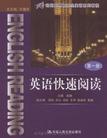英语快速阅读(第一册)
出版时间:2009-4 出版社:中国人民大学出版社 作者:吴静 页数:114
前言
根据1993年国家教委颁布的《非英语专业研究生英语(第一外语)教学大纲》,硕士生外语教学的目的是培养学生具有较熟练的阅读能力,一定的写、译能力和基本的听、说能力,能够以外语为工具进行本专业的学习和研究。可以看出,研究生英语教学仍把阅读教学放在各项技能的首位。此外大纲还具体规定了研究生在经过基础阶段的学习之后,在阅读能力方面须达到的要求:掌握并能运用各项阅读技能(如概括中心思想、猜同悟意、预见、推理和推论等),具有语篇水平的分析能力。能较顺利地阅读并正确理解有相当难度的一般性题材文章和其他读物,速度达到每分钟60词~70词,读后能够理解中心思想及内容。计时阅读难度略低、生词不超过总词数2%的材料,速度达到每分钟100词~120词,读后能理解中心思想及主要内容。由此可见,深化阅读教学,进一步提高阅读能力,仍是培养和提高研究生语言运用能力的关键所在。 本套教材是以《非英语专业研究生英语(第一外语)教学大纲》为指南,在参考国内外多种英语快速阅读教材的基础上,根据编者多年从事研究生英语快速阅读教学的经验,以及我国非英语专业研究生目前整体英语水平和实际英语能力,经过编委会认真、广泛的讨论之后编写而成的。 《英语快速阅读》分第一、二两册,供非英语专业硕士或博士研究生一学年使用,与中国人民大学出版社出版的《新编研究生英语系列教程》(第二版)、《研究生英语系列教材》(第三版)和《研究生英语综合教程》配合使用。本套教材旨在帮助读者扩大英语词汇量,提高阅读速度和阅读理解能力,广泛深入地了解世界各国,尤其是欧美国家的历史文化、风土人情以及自然科学和人文科学等方面的知识。 本套教材编写严谨。第一册遵循理论与实践相结合的原则,讲练结合,分为两大部分:(1)快速阅读概述及应试技巧;(2)快速阅读练习,共32篇短文。第二册共精选短文48篇,内容涉及中西文化、教育、生活、媒介、历史、科技、哲学、文学等,按阅读量与难度的递增分为3个部分,每部分包括16篇文章。两册书选材的原则突出体现科学性、信息性、可读性和趣味性,内容丰富、有趣、时尚,旨在帮助学生进行系统的、有针对性的快速阅渎训练,掌握基本阅读技能,培养良好阅读习惯,提高阅读效率。练习形式多样,既有选择填空的客观题型,又有简短回答、填空、对错判断等主观题型;既注重寻读、略读、猜词悟意、写摘要等快速阅读基本技能的训练,又与各级考试的阅读题型相结合;每册书后附有本册书练习的参考答案供师生参考。使用本套教材非常有利于学生通过各种水平的英语考试。 书中部分文章的版权分别属于不同的个人或机构,请各版权持有者通过出版社与本书编者联系处理。 南于编者水平有限,书中错误疏漏之处在所难免,敬请广大读者和同行专家批评指正。 编者 2009年2月
内容概要
本套教材是以《非英语专业研究生英语(第一外语)教学大纲》为指南,在参考国内外多种英语快速阅读教材的基础上,根据编者多年从事研究生英语快速阅读教学的经验,以及我围非英语专业研究生目前整体英语水平和实际英语能力,经过编委会认真、广泛的讨论之后编写而成的。本书为第一册,该册遵循理论与实践相结合的原则,讲练结合,分为两大部分:(1)快速阅读概述及应试技巧;(2)快速阅读练习,共32篇短文。书中选材的原则突出体现科学性、信息性、可读性和趣味性,内容丰富、有趣、时尚,旨在帮助学生进行系统的、有针对性的快速阅读训练,掌握基本阅读技能,培养良好阅读习惯,提高阅读效率。其练习形式多样,既有选择填空的客观题型,又有简短回答、填空、对错判断等主观题型。另外,书后还附有本册书练习的参考答案供师生参考,使用本套教材非常有利于学生通过各种水平的英语考试。
书籍目录
第一章 快速阅读概述第二章 快速阅读应试技巧(一)第三章 怏速阅读应试技巧(二)第四章 快速阅读练习 Passage 1 Passage 2 Passage 3 Passage 4 Passage 5 Passage 6 Passage 7 Passage 8 Passage 9 Passage 10 Passage 11 Passage 12 Passage 13 Passage 14 Passage 15 Passage 16 Passage 17 Passage 18 Passage 19 Passage 20 Passage 21 Passage 22 Passage 23 Passage 24 Passage 25 Passage 26 Passage 27 Passage 28 Passage 29 Passage 30 Passage 31 Passage 32参考答案常用词缀表
章节摘录
No one likes being jolted awake from a deep sleep,especially when what rlied you up was an assailant,a snake in the bed,or being engulfed by flames.Bad dreams-or worse,mghtmares-arent just annoying;when reoccurring,they can disrupt a good nightS sleep,and sometimes,life. On the spectrum of dreams,missing an important exam or showing Up naked to work place in comparison to nightmares,which are defined as bad dreams that wake the sleeper.They occur during rapid eye movement(REM)late in the evening and because we jerk awake during them,we usually remember all too clearly the fear,anxiety,and horrors. Though more common among children,nightmares and bad dreams happen throughout life.But is there anything we can do to prevent the bad things from creeping into our sleep? 1.Anxiety and Stress Anxiety and stress,often as the result of a traumatic life event,are sometimes the cause of nightmares and bad dreams.According to the International Association f.or the Study of Dreams(IASD),a major surgery or illness,grieving over the loss of a loved one.and suffering or witnessing an assault or major accident can trigger bad dreams and nightmares·Post-Traumatic Stress Disorder(PTSD)is also a common cause of recurrent nightmares. Not all nightmare triggers have to be traumatic,however.Everyday stressors.such as job or financial anxie~~,or major life transitions such as moving or divorce,can also cause nightmares. 2.Spicy Foods When and what we eat may affect our nighttime rest,if not Our tendency toward bad dreams.A small study published in the InternationalJournal of Psyhopbysiologyhad a group of healthy men eat spicy meals before bed on some evenings and conlparedtheir quality of sleep on nights where they had non-spiced meals.On the spicy nights,the subjects spent more time awake and had poorer quality sleep.The explanation isthat spicy food can elevate body temperatures and thus disrupt sleep.This may also bethe reason why some people report bad dreams when they eat too close to bedtime.Though few studies have looked at it,eating close to bedtime increases metabolism and brain activity and may prompt bad dreams or nightmares. 3.Fat Content of Food Though far from conclusive,some research has indicated that the more high.fatfood you consume during the day,the greater the chance that the amount and quality of your sleep may suffer.A small study published in 2oo7 in Psychological Reportsfound that the dreams of people who ate a high amount of organic food differed fromthose who ate“junk foods”.The authors hypothesize that certain foods may negativelyinfluence dreaming. 4.Alcohol Though alcohol is a depressant that will help you fall asleep in the short term,onceits effects wear off,it can cause you to wake up prematurely.Excess consumption canalso lead to nightmares and bad sleep;nightmares are also a common occurrence forthose going through alcohol withdrawal. 5.Drugs Some drugs,including antidepressants,barbiturates,and narcotics,can causenightmares as a side effect.For instance,a 2oo8 study published in the journalPsychopharmacology looked at ketamine,a drug used in anesthesia and recreationally,and found that compared with a placebo,ketamine use resulted in more dreamunpleasantness and increased the incidence of bad dreams.Similarly,anvone who hastraveled to a country where malaria is endemic may have taken Lariam and had someinteresting nightmares associated with it.Nightmares usually cease once the drug iscleared from the system. 6.Illness Illnesses that include fever,such as the flu,can often trigger nightmares.And othersleeping disorders,including apnea and narcolepsy,may also increase the incidence ofbad dreams and nightmares. While bad dreams and nightmares are considered normal responses in dealing witheveryday experiences,the IASD recommends consultation with a therapist if they last inintensity and severity.But trying to eliminate these six factors first may be the best placeto start in your quest to sweeten your dreams and chase the nighttime demons away.
编辑推荐
《英语快速阅读》分第一、二两册,供非英语专业硕士或博士研究生一学年使用,与中国人民大学出版社出版的《新编研究生英语系列教程》(第二版)、《研究生英语系列教材》(第三版)和《研究生英语综合教程》配合使用。本套教材旨在帮助读者扩大英语词汇量,提高阅读速度和阅读理解能力,广泛深入地了解世界各国,尤其是欧美国家的历史文化、风土人情以及自然科学和人文科学等方面的知识,培养读者的世界眼光和跨文化意识。 两册书选材的原则突出体现科学性、信息性、可读性和趣味性,内容丰富、有趣、时尚。练习形式多样,既有选择填空的客观题型,又有简短回答、填空、对错判断等主观题型;既注重寻读、略读、猜词悟意。写摘要等快速阅读基本技能的训练,又与各级考试的阅读题型接轨。使用本套教材十分有利于学生通过各种水平的英语考试。
图书封面
评论、评分、阅读与下载
